Network Multicast Explained: Protocols and Implementations Guide
 Hidayah Ramadlana
Hidayah Ramadlana
Understanding IGMP and PIM in Multicast Networking
In the realm of multicast networking, two essential protocols play distinct but complementary roles: IGMP (Internet Group Management Protocol) and PIM (Protocol Independent Multicast). Understanding how these protocols work together is crucial for managing multicast traffic effectively across networks.
The Role of IGMP
IGMP is a protocol used for managing multicast group memberships within a local network. It allows devices to signal their interest in receiving multicast traffic, ensuring that multicast data is only sent to devices that have explicitly requested it. IGMP operates within a single network segment or subnet, making it highly effective for managing multicast traffic locally. Key Functions of IGMP:
Group Membership Management: IGMP helps routers and switches determine which devices (hosts) are part of a multicast group.
Efficient Multicast Distribution: By informing network devices of which groups are active, IGMP helps to minimize unnecessary multicast traffic and optimize bandwidth usage.
The Role of PIM
PIM is designed to extend multicast traffic beyond the boundaries of a single local network. While IGMP handles group membership within a network, PIM is responsible for routing multicast traffic between different networks, enabling it to traverse routers and various network segments. Key Functions of PIM:
Multicast Routing: PIM creates and maintains multicast distribution trees that span multiple networks, facilitating the delivery of multicast traffic to devices across different network segments.
Protocol Independence: PIM operates independently of the underlying unicast routing protocol (e.g., OSPF, EIGRP, BGP), allowing it to work with various network setups.
How IGMP and PIM Work Together
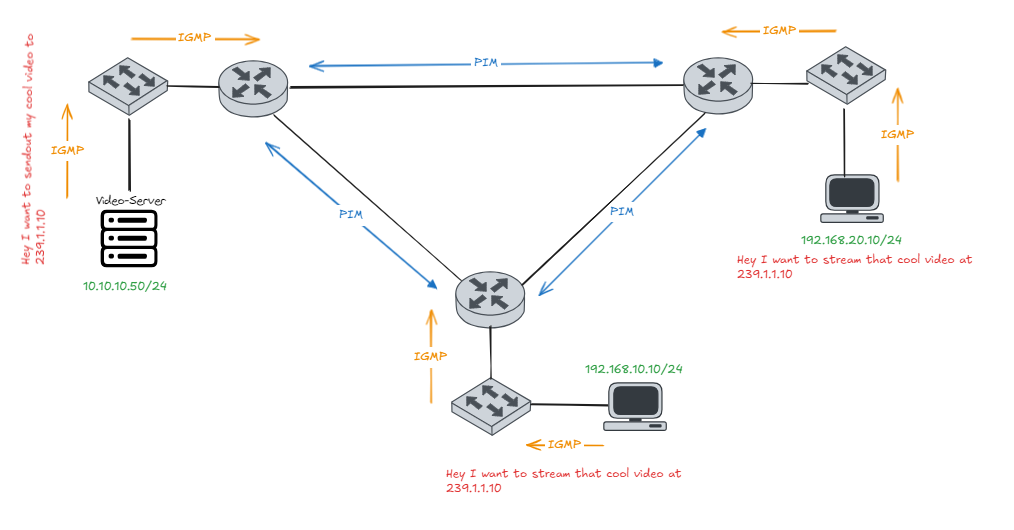
The interaction between IGMP and PIM is crucial for effective multicast communication. Within a local network, IGMP ensures that multicast traffic is only sent to interested devices. When multicast traffic needs to be sent to or from devices across different networks, PIM takes over, routing the traffic between networks and ensuring that it reaches its intended destination. In summary:
IGMP is essential for managing multicast group memberships locally, ensuring efficient multicast traffic distribution within a single network segment.
PIM complements IGMP by enabling multicast traffic to traverse multiple networks, allowing multicast communication to extend beyond local boundaries.
Multicast PIM - Neighbor discovery
In a PIM domain, each PIM interface on a router periodically multicasts PIM hello messages to all other PIM routers (identified by the address 224.0.0.13) on the local subnet. Through the exchanging of hello messages, all PIM routers on the subnet determine their PIM neighbors, maintain PIM neighboring relationship with other routers, and build and maintain SPTs.
Multicast PIM - Reverse Path Forwarding (RPF)
Reverse Path Forwarding (RPF) is a fundamental mechanism in multicast routing that ensures data packets are forwarded along the correct path back to the source. RPF uses the existing unicast routing table to determine the preferred path for incoming multicast packets, ensuring that data is only accepted and forwarded if it arrives on the expected interface. This mechanism prevents loops and ensures that multicast traffic is efficiently routed through the network.
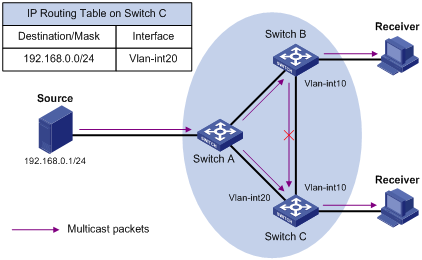
Image Source: RPF check mechanism (hpe.com)
RPF Mechanism The RPF process works as follows:
When a multicast packet arrives at a router, the router checks its unicast routing table to determine the preferred path to the packet's source.
If the packet arrives on the interface that matches the preferred path, it is accepted and forwarded to the next hop.
If the packet arrives on a different interface, it is discarded to prevent routing loops and inefficiencies. This mechanism ensures that multicast traffic flows along the most efficient path, leveraging the existing unicast routing infrastructure to maintain optimal performance. RPF Example Consider a multicast packet with a source IP address of 10.1.1.1 and a destination multicast address of 239.1.1.1. If this packet arrives at a router on both port1 and port2, the router uses the unicast routing table to determine the best path to reach 10.1.1.1. If the unicast route indicates that the preferred path to 10.1.1.1 is through port1, the packet arriving on port1 is accepted and forwarded, while the packet arriving on port2 is discarded. This ensures that the multicast traffic follows the most efficient route, minimizing unnecessary load on the network.
PIM Dense Mode (PIM-DM)
Characteristics of PIM-DM PIM Dense Mode (PIM-DM) is a multicast routing protocol that operates under the assumption that multicast receivers are densely distributed throughout the network. In PIM-DM, multicast traffic is initially flooded to all PIM-enabled routers. This approach ensures that all potential receivers have access to the multicast data, but it can result in significant overhead if many routers do not have interested receivers. Flood and Prune Mechanism
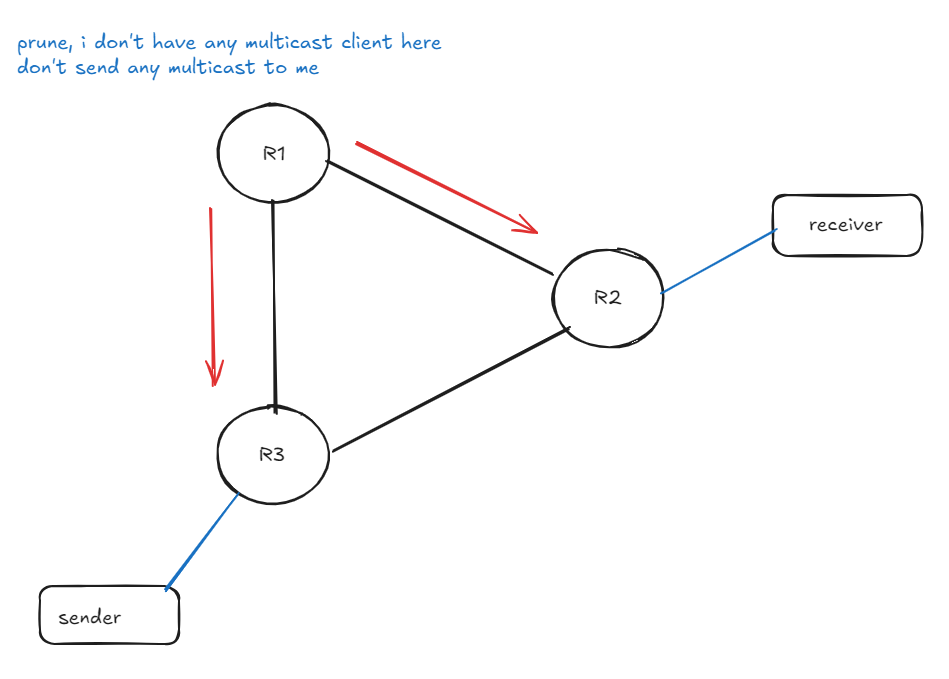
PIM-DM Flooding: When multicast traffic is first introduced into the network, it is flooded to all PIM-enabled routers. This ensures that all potential receivers receive the multicast data. PIM-DM Pruning: Routers that do not have any interested multicast receivers send a prune message upstream, instructing the upstream router to stop sending multicast traffic to them. This process continues until multicast traffic is only sent to routers with interested receivers. This mechanism helps to reduce unnecessary traffic and optimize the use of network resources, but it can be inefficient in networks with sparse multicast receivers. PIM-DM Draft is used to facilitate the process of rejoining a multicast group that was previously pruned. When a network segment or router has been pruned (i.e., multicast traffic was stopped), if a new receiver expresses interest in that multicast group, the network needs a way to handle this rejoining. Benefits and Drawbacks of PIM-DM Benefits:
Simple to implement and configure.
Ensures all potential receivers initially receive the multicast data. Drawbacks:
Inefficient in networks with sparse receivers, leading to excessive flooding and pruning.
Higher bandwidth consumption due to initial flooding.
PIM Sparse Mode (PIM-SM)
Characteristics of PIM-SM PIM Sparse Mode (PIM-SM) operates under the assumption that multicast receivers are sparsely distributed throughout the network. Unlike PIM-DM, PIM-SM uses a more controlled approach to multicast traffic distribution, relying on a central Rendezvous Point (RP) to manage group memberships and traffic forwarding.
Shared Tree (RPT) In PIM-SM, the initial multicast traffic is sent to a Rendezvous Point (RP), which maintains a shared tree (RPT) connecting all routers with interested receivers. The steps are as follows:
A router interested in receiving multicast traffic for a group sends a join message towards the RP.
The RP builds a shared tree connecting all receivers.
Multicast traffic from the source is sent to the RP, then distributed to all receivers via the shared tree. Source Tree (SPT) After the initial multicast traffic is delivered via the shared tree, routers can transition to a Source Tree or Short Path Tree (SPT) for more efficient delivery. The steps are as follows:
Once a receiver router receives multicast traffic from the RP, it learns the source's IP address.
If there is a more efficient path to the source, the router builds a source tree specific to that source.
Future multicast traffic is received directly from the source via the source tree, optimizing the delivery path.
PIM Sparse Mode use Register and Register Stop to handle multicast source registration PIM Register: Used to inform the RP about the source and to forward multicast traffic to the RP. PIM Register-Stop: Tells the local router to stop sending Register messages once the RP confirms there are interested receivers.
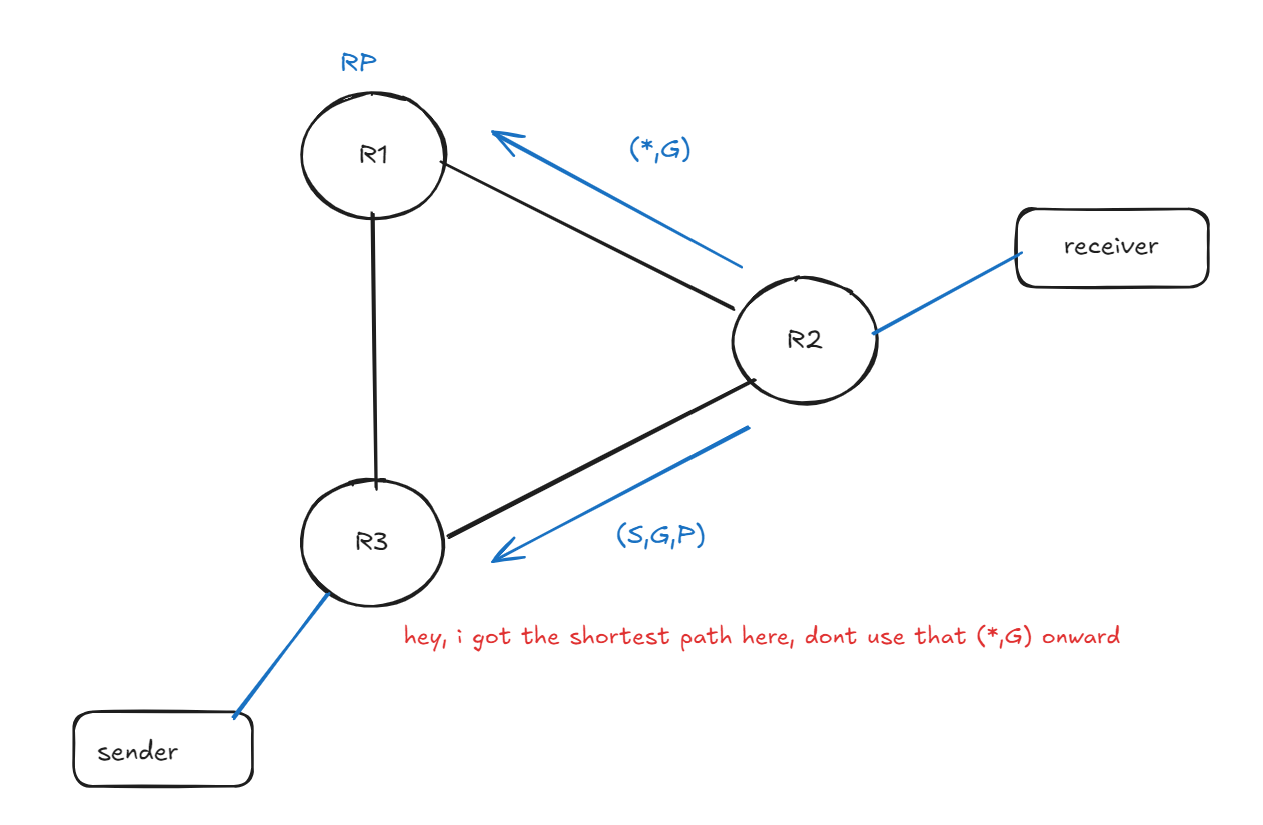
Transition from Shared Tree to Source Tree This transition from the shared tree to the source tree enhances efficiency by ensuring that multicast traffic follows the shortest possible path to each receiver. This reduces latency and conserves bandwidth, particularly in large networks with diverse multicast sources and receivers.
PIM Sparse Mode Auto-RP
In PIM multicast routing, the Rendezvous Point (RP) is a crucial component that facilitates the distribution of multicast traffic to receivers. Auto-RP automates the process of discovering and advertising RP information, making it easier to deploy and manage multicast routing. Note: Auto-RP is applicable only to PIM-SM.
Mapping Agents: These are routers that listen for RP announcements and distribute RP information to the rest of the network.
Candidate RPs: These are routers that volunteer to act as RPs and advertise their willingness to serve as an RP to the network.
Auto-RP Components: Candidate RP (CRP): A router that wants to be an RP will use Auto-RP to advertise itself as a candidate. This advertisement includes information such as the multicast groups it is willing to support. Mapping Agent (MA): A router that listens for Candidate RP advertisements and distributes RP information throughout the network. Rendezvous Point (RP): Once elected, the RP is responsible for managing multicast groups and forwarding multicast traffic.
PIM Source-Specific Multicast (PIM-SSM)
Overview of PIM-SSM PIM Source-Specific Multicast (PIM-SSM) is a variant of PIM designed to enhance the efficiency and security of multicast traffic delivery. In PIM-SSM, multicast receivers specify both the source and the group they are interested in, allowing for more precise and efficient routing of multicast traffic. Notes:
Its Required IGMPv3 enabled within networks. PIM SSM relies on the capability of IGMPv3 to handle source-specific multicast group memberships. IGMPv3 enables the receiver to explicitly specify the source addresses it wants to receive traffic from, which is a fundamental requirement for PIM SSM.
(*;G) are not exist on PIM-SSM
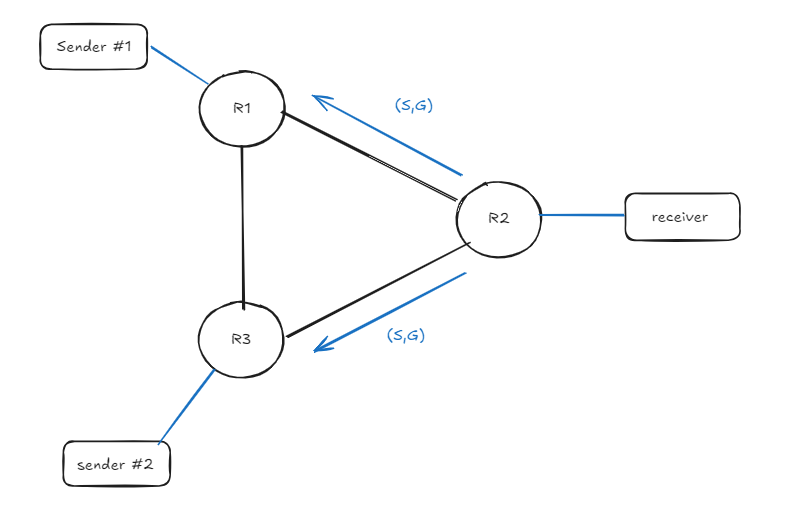
Advantages of PIM-SSM
Increased Security: By allowing receivers to specify the source, PIM-SSM reduces the risk of unwanted or malicious multicast traffic.
Improved Efficiency: PIM-SSM optimizes the delivery of multicast traffic by ensuring it only flows from the specified source to interested receivers, reducing unnecessary traffic.
Simplified Management: PIM-SSM simplifies the management of multicast groups by reducing the complexity of group membership and traffic forwarding.
PIM Bidirectional (PIM-BIDR)
Overview of PIM-BIDR In PIM BIDIR, the RP serves as the central point through which all multicast traffic is exchanged. It plays a key role in bidirectional multicast communication, ensuring that multicast traffic can flow in both directions—between sources and receivers. Multiple RPs can be manually configured. The network can be set alternate RP if the primary RP fails.
PIM BIDIR is a variant of PIM-SM, similar to SSM, and is particularly useful when most receivers are also senders, such as in videoconferencing scenarios. In PIM BiDir, all participants join a single distribution tree rooted at the RP. Unlike the unidirectional trees in PIM-SM, BiDir allows traffic to flow both up and down the tree. When a source sends multicast packets, they travel up to the RP and then down to all receivers.
To establish the bidirectional tree, PIM elects Designated Forwarders (DFs) for each link. The DF is selected based on the shortest metric to the RP, similar to the PIM Assert procedure. PIM Assert Procedure is Mechanism that optimizes multicast traffic by stopping the forwarding of multicast traffic on specific interfaces where there are no interested receivers. DFs are the only routers allowed to forward traffic upstream towards the RP.
Each router in a PIM BIDIR network maintains a (*, G) state for each bidirectional group, with an Outgoing Interface List (OIL) based on PIM Join messages from neighbors, representing the downstream part of the tree.
PIM BIDIR does not use the PIM Register/Register-Stop mechanism for source registration. Sources can start sending multicast traffic at any time; packets will travel upward to the RP and then be either dropped if there are no receivers or forwarded down the BIDIR tree. The RP cannot instruct the source to stop sending traffic.
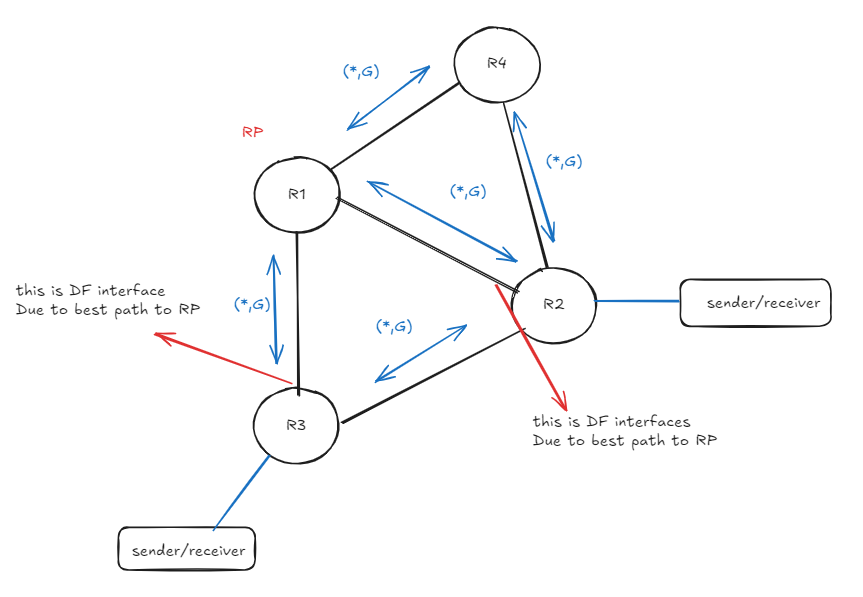
Use Cases for PIM-BIDR
Video Conferencing: PIM-BIDR is ideal for video conferencing applications where participants need to send and receive video streams simultaneously.
Collaborative Work: In collaborative environments, PIM-BIDR allows for efficient sharing of data and resources among multiple users.
Comparing PIM Modes
PIM-DM vs PIM-SM
PIM-DM: Suitable for networks with densely distributed receivers, but can result in excessive flooding and pruning.
PIM-SM: More efficient for networks with sparsely distributed receivers, using a central RP to manage group memberships and traffic.
PIM-SSM vs PIM-BIDR
PIM-SSM: Focuses on source-specific multicast traffic, enhancing security and efficiency by allowing receivers to specify both the source and the group.
PIM-BIDR: Optimized for bidirectional traffic flows, ideal for applications requiring simultaneous send and receive capabilities.
Implementing PIM in Networks
PIM Configuration Steps
Enable PIM on Interfaces: Configure PIM on the interfaces of routers that will participate in multicast routing.
Configure Rendezvous Points (RP): For PIM-SM, designate and configure RPs to manage group memberships and traffic forwarding.
Establish Multicast Routing Policies: Define policies to control the flow of multicast traffic and manage group memberships. Common Challenges and Solutions
Challenge: Managing multicast group memberships in large networks. Solution: Use automated tools and protocols like IGMP to simplify membership management.
Challenge: Ensuring efficient routing of multicast traffic. Solution: Leverage RPF checks and transition to source trees for optimized delivery.
Use Cases and Applications of PIM
Real-World Examples
Live Streaming: PIM is used to efficiently distribute live video streams to large audiences. Live streaming mean user stream the video at same time without have any control to video playback such as Forward, Backward, Timestamp slider and so on.
Online Gaming: Multicast traffic optimizes the delivery of real-time game data to multiple players.
Industry Applications
Finance: Real-time stock ticker updates and financial news distribution.
Education: Distance learning and virtual classrooms benefit from efficient multicast traffic delivery.
Switch Role as IGMP Snoop
Snoop Multicast Information between host and router. Overview of IGMP Snooping IGMP (Internet Group Management Protocol) Snooping is a network switch feature that allows the switch to listen in on IGMP conversations between hosts and routers. By doing so, the switch can intelligently forward multicast traffic only to ports that are part of the multicast group, preventing unnecessary traffic from being sent to all ports. Benefits of IGMP Snooping
Traffic Optimization: IGMP Snooping significantly reduces multicast traffic by ensuring that multicast packets are only sent to ports with interested receivers.
Enhanced Performance: By limiting unnecessary traffic, IGMP Snooping improves the overall performance and efficiency of the network.
Bandwidth Conservation: By preventing multicast packets from flooding the entire network, IGMP Snooping conserves valuable bandwidth, particularly in large and complex networks.
FAQs on Protocol Independent Multicast (PIM)
What is Protocol Independent Multicast (PIM)? PIM is a multicast routing protocol that operates independently of specific unicast routing protocols, enabling efficient distribution of multicast traffic across IP networks.
How does Reverse Path Forwarding (RPF) work? RPF ensures that multicast packets are accepted only if they arrive on the correct interface, as determined by the unicast routing table, preventing loops and optimizing traffic flow.
What are the differences between PIM-DM and PIM-SM? PIM-DM assumes densely distributed receivers and uses a flood and prune mechanism, while PIM-SM assumes sparsely distributed receivers and uses a Rendezvous Point to manage traffic.
What is the purpose of PIM-SSM? PIM-SSM allows receivers to specify both the source and the group for multicast traffic, enhancing security and efficiency by reducing unnecessary traffic.
When is PIM Bidirectional (PIM-BIDR) used? PIM-BIDR is used in scenarios with bidirectional traffic flows, such as video conferencing and collaborative work, enabling efficient routing in both directions.
What are the benefits of multicast routing? Multicast routing optimizes bandwidth use, improves scalability, and enhances network performance by delivering data to multiple recipients simultaneously.
Conclusion
Summary of Key Points Protocol Independent Multicast (PIM) is a versatile and efficient multicast routing protocol that operates independently of specific unicast routing protocols. It offers various modes, including PIM-DM, PIM-SM, PIM-SSM, and PIM-BIDR, each suited to different network environments and requirements. Understanding and implementing PIM can significantly enhance the efficiency and performance of multicast traffic in IP networks. Final Thoughts on PIM PIM remains a critical component of modern IP networks, providing the scalability, efficiency, and flexibility needed to support a wide range of multicast applications. As networks continue to evolve, the ongoing development and integration of PIM with emerging technologies will ensure its relevance and effectiveness in meeting future multicast routing challenges.
Subscribe to my newsletter
Read articles from Hidayah Ramadlana directly inside your inbox. Subscribe to the newsletter, and don't miss out.
Written by

Hidayah Ramadlana
Hidayah Ramadlana
I love to problem solve using a technology including software, networking and cloud computing. Currently work as Network and Cloud engineer but in day to day I also write a code to automate and make our team work easier